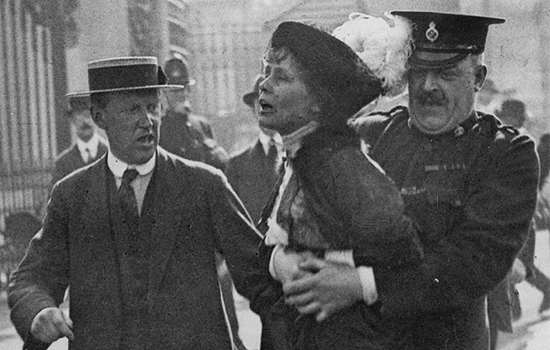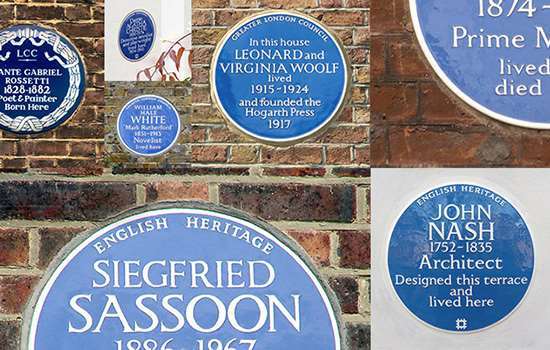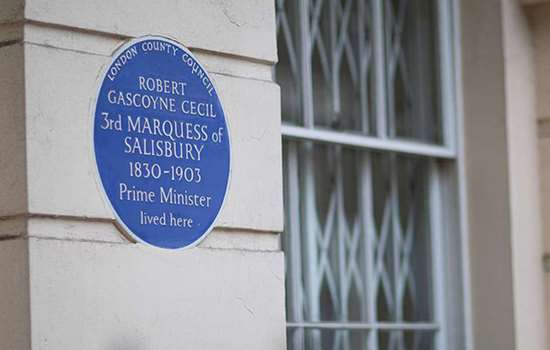NEVINSON, CRW (1889-1946) & NEVINSON, Henry (1856-1941)
Plaque erected in 2018 by English Heritage at 4 Downside Crescent, Hampstead, London , NW3 2AP, London Borough of Camden
All images © English Heritage
Profession
Artist, Journalist
Category
Fine Arts, Journalism and Publishing
Inscription
HENRY NEVINSON 1856-1941 Journalist C.R.W. NEVINSON 1889-1946 Artist lived and worked here
Material
Ceramic
Henry Nevinson and his son CRW Nevinson are commemorated at their former home, 4 Downside Crescent in Hampstead. Henry was a renowned war correspondent, social justice campaigner and supporter of women’s suffrage, while his son Richard was an avant-garde artist who promoted Futurism in the UK and depicted enduring images of First World War.
HENRY NEVINSON
Henry Woodd Nevinson enjoyed a reputation as a champion of liberty, as well as the ‘king of war correspondents’. His experience as a temporary correspondent on the Greco–Turkish war in 1897 gave him ‘six weeks of higher happiness than man has ever known’. It also launched his globe-trotting career, covering conflicts in the Balkans (1897), Spain (1898) and the Boer war in South Africa from 1899. In 1904 he was sent by Harper’s Monthly Magazine to investigate the trafficking of Angolans to work under slave-like conditions in cocoa plantations in the Portuguese-ruled islands of São Tomé and Príncipe. In his reports and his book A Modern Slavery (1906), he urged the major companies – Cadbury’s, Fry and Rowntree – to boycott the islands’ cocoa trade, with some success. Nevinson also witnessed the 1905 Russian revolution at first hand and, after reporting from India, advocated Indian independence.
Henry was an active supporter of the suffragette movement – a cause he shared with his wife Margaret and with Evelyn Sharp, a friend and mistress who became his second wife. In 1907 he was one of the founders of the Men’s League for Women’s Suffrage. Two years later he – along with Henry Brailsford – resigned from The Daily News when the editor refused to condemn the force-feeding of suffragette prisoners on hunger strike. Nevinson was also a founder member of the more militant Men’s Political Union for Women’s Enfranchisement (1909) and the United Suffragists (1913).
Nevinson continued to report on international affairs, visiting America, Palestine, Syria and Iraq. In the late 1930s the accounts of atrocities against Jewish people in Nazi Germany led him to state that it was ‘our national duty to strike against cruelty and injustice wherever it appeared’. In 1940 Nevinson reluctantly moved to Chipping Campden, Gloucestershire, after bombing made 4 Downside Crescent uninhabitable. He died the following year.
CRW NEVINSON
Christopher Richard Wynne Nevinson was the only son of Henry and Margaret Nevinson. He studied at the Slade School of Fine Art, where his fellow students included Mark Gertler, Edward Wadsworth, Stanley Spencer, William Roberts, David Bomberg and Dora Carrington. His painting The Departure of the Train De Luxe (1913), has been cited as the first English Futurist picture. In 1914 Nevinson jointly published a manifesto for Futurist ideals, Vital English Art, with the leader of the movement, Filippo Marinetti. He discarded the Futurist label towards the end of 1915.
Richard’s brief and harrowing experience on the Western Front inspired new work, which portrayed the brutality of war. His paintings displayed at the second London Group exhibition in March 1915 received good reviews, in particular Returning to the Trenches – a portrayal of marching soldiers, grimly joined in step and purpose. In May 1917 he became a temporary official war artist, but not all of his works were well received. Two paintings – A Group of Soldiers and Paths of Glory, the latter showing two slaughtered soldiers – became the subject of a controversy over censorship.
In later years Richard became increasingly unhappy, belligerent and mentally unstable. He also had a series of strokes in 1942 and 1943 that may have affected his mental state. During this time he lashed out at former teachers and friends in his journalism, and expressed anti-Semitic views in his memoirs and letters. He died of heart disease on 7 October 1946.
4 DOWNSIDE CRESCENT
Henry Nevinson wrote 27 of his 34 books at Downside Crescent, and much of his journalism was undertaken at the house too. It was to number 4 that he returned after meetings, marches, and travels to difficult and sometimes dangerous places. Visitors to Downside Crescent included an international array of friends, journalists, military men, and a new generation of leaders including India's future Prime Minister Jawaharlal Nehru, as well as the poet and fellow Hampstead resident Rabindranath Tagore. For the 1911 census, Henry supported the suffrage passive resistance campaign by listing only himself, his son Richard, and two servants in his return. He added the comment: ‘Other women were staying in the house but they refused consent to the census on the ground that women have no representation in the country’s government’.
Richard Nevinson came to Downside Crescent as a teenager and left it a married man, some 16 years later. It was while living here that his artistic talent and ideas matured. His fellow Slade students were frequent visitors to the house, and the Futurists Severini and Marinetti had supper here during their London visits. It was while at Downside Crescent that Nevinson made his reputation as a war artist, and it therefore represents arguably the most significant part of his career.
Nearby Blue Plaques
More About Blue Plaques



